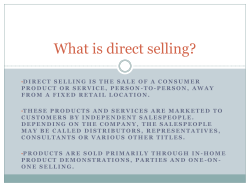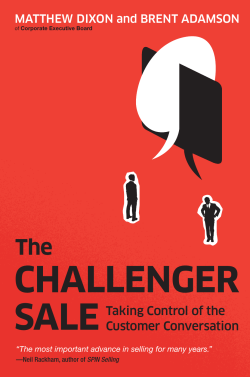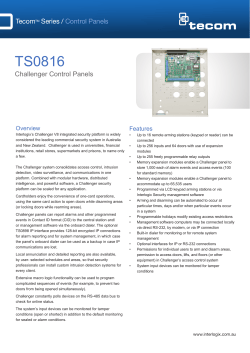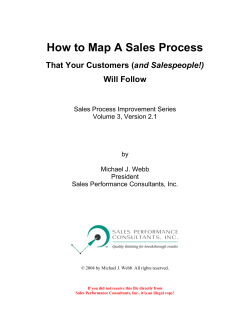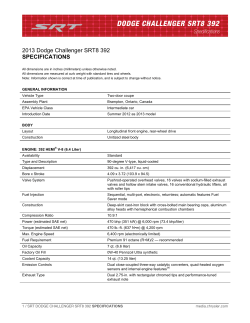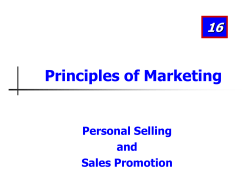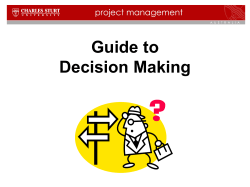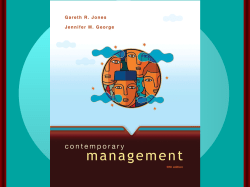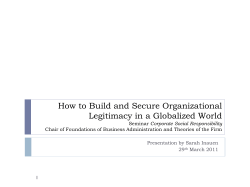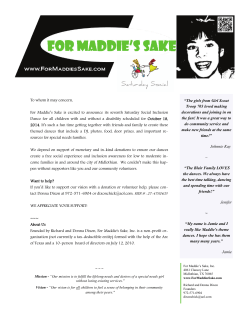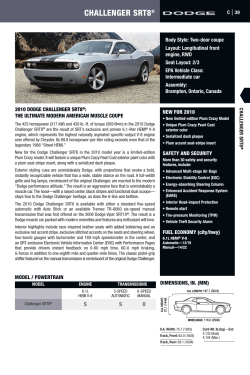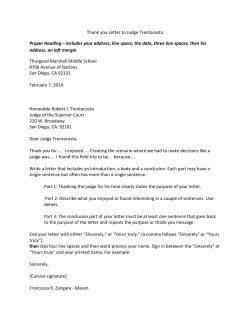
Enabling the Challenger Sale by David Chapnick
Enabling the Challenger Sale by David Chapnick You do not have to have been born a Challenger to succeed, but you do need to know what the right preparation strategy is and how to leverage it. The research outlined by the recent book The Challenger Sale: Taking Control of the Customer Conversation 1 has created a paradigm shift in what we know about how effective salespeople interact with customers “at the table.” Based on the research by Dixon and Adamson, “Challengers” are reported to be better equipped and better able to influence customer purchases than any other type of salesperson. Challengers do this by providing customers with new or unique insights into the market or on how their customer can save or make money through process improvements and product innovation; work with their customers to customize and create potential solutions; and close with judicious assertiveness and sound justification for why a particular solution makes sense, at that price, at that time. These are the three core behaviors that Dixon and Adamson say Challengers do most effectively with their customers: QQ Teach for Differentiation QQ Tailor for Resonance QQ Take Control of the Sale However, knowing what to do to be a successful Challenger, and knowing how to do it are fundamentally different questions. It is the latter question that we hear most often from our clients. As Dixon and Adamson rightly point out, sales executives know that there is “potentially huge commercial value currently locked up in the middle 60% of the sales force,” but how we raise the bar of so-called “core performers” is the true challenge. This is especially difficult as so many core performers are not challengers at all. And that is fundamentally the point. Whether your salespeople are innately “challengers” or not, all salespeople can Teach, Tailor, and Take Control, if they have done the right preparation and are supported by their organization with the right processes and tools. Preparing systematically for each customer encounter is at the center of successful sales strategy execution. Too often we hear of sales people running from sales call to sales call, and customer to customer, without having sat back and truly given thought to the objectives of each interaction, and how each can and should be used further their position. Using the Challenger framework as guidance, successful sales people can consider ahead of time what they will need to accomplish in their meetings, and specifically how they will go about doing so. Teach for Differentiation by Understanding Customer Interests At its core, Teaching for Differentiation means understanding what customers truly care about, their interests — what they truly value, what strategy they are looking to execute, and what they believe will help them get there — and helping them to understand how the solutions you offer can help meet them. Knowing their interests as well as they do, and supporting them as they uncover interests that they did not know they had, requires significant preparation. 1 Dixon, Matthew and Brent Adamson. The Challenger Sale: Taking Control of the Customer Conversation. Penguin Group USA: New York. ©2011 1 Challenger says… Prepare by… Teach for Differentiation Tailor for Resonance Take Control of the Sale Understanding customer interests Generating possible options Identifying standards of legitimacy Testing customer alternatives As you prepare, consider what you know and don’t know about your customer. The illustrative questions below can help you fill in the picture: QQ QQ QQ QQ QQ QQ Why… Does your customer care only about price, or do they care about quality, total cost of ownership, technology, customer service, or other differentiators? How are they being measured and incented (as that will likely determine what they care about)? Are there other stakeholders that will play a role in the buying decisions, and if so what do they care about (because you will have to satisfy their interests as well, if you want to close the deal)? What technical or financial challenges are they facing? Are they short-term or long-term? Are there interests that you can imagine they might or should have but which they may not fully understand (e.g., because of coming market changes, disruptive technologies, competitor actions, where their own customers are heading, etc.)? How does your customer weigh and prioritize those many interests? Prepare what you know, and be prepared to Any deal that your customer will ultimately agree to has to meet their interests Allows you to offer targeted business insights to the customer and be seen as a trusted, credible, and persuasive advisor Getting all of the possible solutions on the table before moving to a commitment helps to develop the most creative deal Determining which options a customer likes or does not and why helps you to better understand their true interests Ensures that the deal is fair and defensible to stakeholders internally and at the customer Provides non-arbitrary ways to resolve conflicting interests and positions in negotiations Any deal has to better meet the customer’s interests than the competition ask them about what you don’t, with good questions that help them to better understand their own interests as well. At the same time, prepare insights that you have gleaned from your dealings with their organization, what you have seen other customers do effectively, and what you see daily in the marketplace. Those insights likely center around interests that your customer may not know they have, and likely would appreciate hearing about. Whether or not you have to truly “challenge” them on their interests, providing such insight in an educated, well-prepared, and thoughtful manner is a way to provide real value, and position yourself as a trusted advisor, rather than simply another salesperson. One helpful way in which you might do this is through “hypothesis-driven questions.” Ask questions with an eye toward testing hypotheses of what they might need to be considering for their business. These are not just general questions like “Where is your business headed?”, “What are you seeing in the market?”, or “Where is your competition focused?”, but are based on your own understanding of their business and their market: “How are you thinking about 2 ____?”, “Are you worried about ____?”, “As we see ____, I wonder if you are concerned with ____?” Filling in those blanks shows Whether or not you have to truly “challenge” them on their interests, providing insight in an educated, well-prepared, and thoughtful manner is a way to provide real value. you care, may shake up the client as they consider something they have perhaps not thought of, provides you with a greater understanding of their interests, and often creates real insight. With such insight, you can begin to generate possible solutions. Tailor for Resonance by Generating Possible Options Challengers are effective at molding, customizing, and shaping their offerings QQ As you test the potential options with your customer, you will uncover more interests that you or they may not have even known about, making the ultimate solution that much better. to the interests and needs of the customer — as Dixon and Adamson say, Tailoring for Resonance. They do this with the customer by using the customer’s interests to develop a creative, final solution, from among all of the possible options that might be provided. Options are all of the myriad ways in which a salesperson and customer might reach agreement — to eventually arrive at a final solution. Too often sales people jump right to what they believe is the final solution and try their heart out to sell it. “What you need is X” or “This will meet your needs” are not uncommon to hear in a typical sales pitch. Rather than jumping straight to the solution, look closely at the customer interests you prepared, and consider, what are ALL of the different ways in which our company might meet them? For instance: QQ QQ QQ QQ QQ QQ QQ What are the potential ways in which we might combine different technologies or services to best meet their needs? What warranties or quality guarantees can we make? What services can we provide along with their purchase? What volume commitments might they make? How long should the duration of the contract be? In what ways might exclusivity agreements benefit each of us? How might payment terms be altered? QQ QQ Would it be helpful for our products be spec’d into their long-term technical roadmaps? How might we be willing to change other terms if they were willing to do so? How might they facilitate closer relationships with the end users of our products/services? Are there other things that we can provide at low cost to us, but of high value to them? And vice versa, are there things they can provide us that are low cost to them, but of high value to us? Answers to these questions are all possible options to bring into, and use to facilitate, your discussions and negotiations with your customers in tailoring the ultimate solution in a way that best meets their needs. As you test the potential options with your customer, it is also possible that you will uncover more interests that you or they may not have even known about, making the ultimate solution that much better. Take Control of the Sale by Identifying Standards of Legitimacy We hear over and over how truly difficult it is to “Take Control of the Sale,” as Challenger prescribes. Procurement groups are increasingly sophisticated in their approach to negotiations and often act as a barrier to technical buyers and end-users. Compounding the difficulty, salespeople are brought in by procurement increasingly later in the buying discussion, often following a due diligence process and when many, if not most, of the parameters of the sale have already been defined. In addition, Procurement is often trained and incented to focus the conversation purely on price, ignoring all other benefits and value that may come with the product or service they are buying. For these reasons it is that much more important to prepare for your customer conversations in a systematic way so that you are ready when you are inevitably “challenged” yourself, on the 3 value of the products and services your company provides. To take control of the sale, walk into your customer conversations having already considered as many “standards of legitimacy” as you can. Standards of legitimacy help you to justify the extent to which an agreement is perceived as fair, appropriate, or “on the merits.” Standards provide non-arbitrary ways to resolve conf licting interests and positions between customers and their suppliers, especially around those that are controversial — pricing, terms, risk sharing, etc. — and help you to choose among possible options based on what is of value to each party, and what a neutral third party would believe are most fair. Standards of legitimacy that you might cite to justify why a certain solution makes most sense, or should cost a certain amount might include: QQ Market pricing, indices, or benchmarks QQ Previous contracts or business history QQ Competitive offerings or pricing QQ The value of the solution that you are providing (for example, the value of what it enables the buyer to do or offer to their own customers or cost savings it may provide them) QQ Cost of inputs or manufacturing, terms QQ Liabilities With a list of possible standards of legitimacy, strategize for your conversations, by considering: QQ QQ QQ QQ How can we best justify the solutions on the table? What standards might an arbitrator or neutral third party apply? What will our customer argue to justify what they believe to be fair? What would be our best response? How could they justify an outcome to their constituents? How can we support them in doing so? Apply the standards that you prepared in your conversations with your customer Turning Challenger Guidance into Action Challenger says… Prepare by… Teach for Differentiation Tailor for Resonance Take Control of the Sale Consider… Understanding customer interests Generating possible options Identifying standards of legitimacy Testing customer alternatives 4 Does your customer care only about price, or do they care about quality, total cost of ownership, technology, customer service, or other differentiators? How are they being measured or incented? Are there other stakeholders that will play a role in the buying decisions, and if so, what do they care about? Are there interests that you can imagine they might or should have, but which they may not fully understand? What are the potential ways in which we might combine different technologies or services to best meet their needs? What warranties or quality guarantees can we make? What services can we provide along with their purchase? What volume commitments might they make? How long should the duration of the contract be? Are there other things that we can provide at low cost to us, but of high value to them? And vice versa? Market pricing, indices, or benchmarks Previous contracts or business history Competitive offerings or pricing The value of the solution that you are providing (e.g., the value of what it enables the buyer to do or to offer to their own customers or cost savings it may provide them) Cost of inputs or manufacturing, terms Liabilities What other competitors’ solutions are they considering? How well do the competitive solutions meet the customer’s interests relative to ours? If our customer was to walk away, what switching costs or other consequences might they face? How can we improve how well our solution meets the customer’s interests relative to the competition’s? How might we worsen their perception of how well competitive solutions meet their interests? How could we test potentially unrealistic expectations they might have about their alternatives? Use standards as a “sword” to persuade the other side why a given solution makes sense. to justify the various options that make most sense, as you craft a final solution. Negotiate defensible and durable agreements with clear standards that ensure that the buyer can explain to their constituents why the solution and the contract is a good one. Use standards as a “sword” to persuade the other side why a given solution makes sense by saying things such as, “The price we are offering is the lowest of any of my customers with your market share and volumes.” At the same time, you can use standards as a “shield” to protect yourself when you are challenged with unreasonable demands by asking things such as “What are you basing that on?” or “Why that number?” You can also rely on the principle of reciprocity by looking for standards or precedents that would seem fair to whichever side one was on. Ultimately, demonstrate that you too are open to persuasion on-the-merits — or else why should your counterpart be? Take Control of the Sale by Testing Customer Alternatives The other lever that you have to Take Control of the Sale is by testing your customer’s alternatives. Alternatives for your customer could be turning to your competitors, using an internal solution, or simply doing nothing. Whatever solution you and your customer settle on must better meet their interests than their alternatives; otherwise you will likely lose the deal. Other than standards of legitimacy, knowing your customer’s alternatives is the other significant source of leverage and power that you have in your customer discussions. If the customer’s alternatives are perceived to be worse than what you are offering, they will likely sign the deal with you. Prepare for your conversations by considering: QQ QQ QQ QQ QQ QQ What other competitors’ solutions are they considering? How well do the competitive solutions meet the customer’s interests relative to ours? If our customer was to walk away, what switching costs or other consequences might they face? How can we improve how well our solution meets the customer’s interests relative to the competition? How might we worsen their perception of how well competitive solutions meet their interests? How could we test potentially unrealistic expectations they might have about their alternatives? Enabling Salespeople to Engage in Challenger Sales In the end, you (or your salespeople) do not have to have been born Challengers to succeed, but you do need to know what the right preparation strategy is and how to leverage it at the table with the customer. Companies we have worked with have taken this advice to heart in how they support their salespeople to do exactly what we have just described. Our clients have embedded the advice above in new sales tools (or by adjusting preexisting ones), which drive consistent preparation approaches for customer meetings and negotiations. They have created new strategies and playbooks for the sales force for more effectively working with procurement and end users. Management has also embraced these new approaches by asking for and reviewing their salespeople’s customer meeting and negotiation plans before they provide authorization for a certain price, or to make a certain deal. Such preparation reviews have been built into agendas for senior executive sales / price council meetings, and occur more informally in regular meetings with managers. These types of actions contribute to building in salespeople new mindset, skills, and understanding for how such interactions with customers ought to occur. Vantage’s interactive and experiential training provides salespeople with knowledge of industry best practices for managing customer interactions and negotiating with procurement. These types of training programs afford participants an informal forum with colleagues and coaches to practice and try out new skills and sales tools — before the stakes are raised in front of the customer — and are a useful communication vehicle for rolling out such significant change efforts. Whether you are a Challenger or not (or whether your sales team is full of them) should not be your primary concern. If you or your sales team walk into your next customer encounter having systematically prepared for the conversation with an understanding of what the customer truly cares about and with insights into what they should be caring about; a set of possible solutions that address those customer interests and concerns; and standards for why a given solution might make sense and why yours is better than the competition’s, then you will be more than ready to challenge for that next sale. About Vantage Partners Vantage Partners, a spin-off of the Harvard Negotiation Project, is a management consulting firm that specializes in helping companies achieve breakthrough business results by transforming how they negotiate, and manage relationships with, key business partners. To learn more about Vantage Partners or to access our online library of research and white papers, please visit: www.vantagepartners.com Vantage Partners | 10 Guest Street, Boston, MA 02135 USA | T +1 617 354 6090 F +1 617 354 4685 | www.vantagepartners.com Copyright © 2013 by Vantage Partners, llc. All rights reserved. 5
© Copyright 2025
